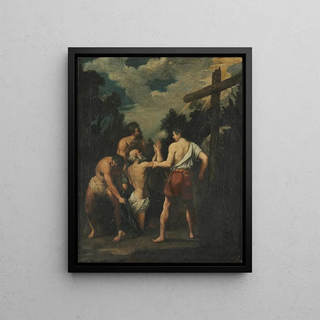Art print | Martyrdom of Saint Andrew - Guido Reni


View from behind

Frame (optional)
In the vast panorama of art history, some works stand out for their emotional intensity and their ability to captivate the observer. "Martyre de saint André" by Guido Reni is one of those masterpieces that, through its dramatic momentum and spiritual depth, transports the viewer to the heart of a transcendent experience. This artwork, created in the 17th century, not only illustrates the exceptional talent of its creator but also highlights the importance of the representation of saints in baroque art. Contemplating this piece, one is immediately struck by the narrative power emanating from each brushstroke, inviting reflection on sacrifice and faith.
Style and uniqueness of the work
Reni's style, characterized by a radiant luminosity and balanced composition, is fully expressed in the "Martyre de saint André." The scene depicts the saint in agony, suspended on a cross in the shape of X, symbolizing his martyrdom. The artist manages to capture the very essence of pain while maintaining a certain serenity in the saint's expression. The drapery, meticulously rendered, reveals remarkable technical mastery, where light and shadow play a crucial role in highlighting the forms. Reni uses a rich palette, blending warm and cool tones, thus creating an atmosphere that is both dramatic and soothing. This duality gives the work an almost mystical dimension, where tragedy and the sacred intertwine harmoniously.
The artist and his influence
Guido Reni, an emblematic figure of Italian baroque, established himself as a master of painting thanks to his unique style and his ability to evoke deep emotions. Born in Bologna in 1575, Reni was trained by renowned artists such as the Carracci, but he quickly developed a personal signature that sets him apart from his contemporaries. His work is characterized by a constant pursuit of ideal beauty, where the harmony of forms and the delicacy of expressions are paramount. Reni's impact on the art world is undeniable, inspiring

Matte finish

View from behind

Frame (optional)
In the vast panorama of art history, some works stand out for their emotional intensity and their ability to captivate the observer. "Martyre de saint André" by Guido Reni is one of those masterpieces that, through its dramatic momentum and spiritual depth, transports the viewer to the heart of a transcendent experience. This artwork, created in the 17th century, not only illustrates the exceptional talent of its creator but also highlights the importance of the representation of saints in baroque art. Contemplating this piece, one is immediately struck by the narrative power emanating from each brushstroke, inviting reflection on sacrifice and faith.
Style and uniqueness of the work
Reni's style, characterized by a radiant luminosity and balanced composition, is fully expressed in the "Martyre de saint André." The scene depicts the saint in agony, suspended on a cross in the shape of X, symbolizing his martyrdom. The artist manages to capture the very essence of pain while maintaining a certain serenity in the saint's expression. The drapery, meticulously rendered, reveals remarkable technical mastery, where light and shadow play a crucial role in highlighting the forms. Reni uses a rich palette, blending warm and cool tones, thus creating an atmosphere that is both dramatic and soothing. This duality gives the work an almost mystical dimension, where tragedy and the sacred intertwine harmoniously.
The artist and his influence
Guido Reni, an emblematic figure of Italian baroque, established himself as a master of painting thanks to his unique style and his ability to evoke deep emotions. Born in Bologna in 1575, Reni was trained by renowned artists such as the Carracci, but he quickly developed a personal signature that sets him apart from his contemporaries. His work is characterized by a constant pursuit of ideal beauty, where the harmony of forms and the delicacy of expressions are paramount. Reni's impact on the art world is undeniable, inspiring






